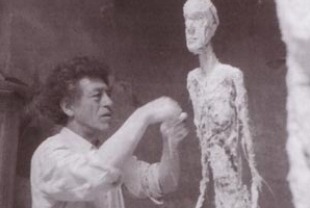Alberto Giacometti (1901 - 1966) was raised in a Swiss family where art was the central focus of life. His father was a distinguished Impressionist painter. Alberto created his first paintings and sculptures when he was an adolescent. He studied in Paris in the 1920s, settling in a small Montparnasse studio. His paintings during this period were influenced by Cezanne and his sculptures were similar to work by Brancusi and the Cubists. In the 1930s, he aligned himself with the Surrealist movement but left in order to fashion his own vision. Giacometti hit high stride during the next decade when he found his own meter with a series of slender sculptures: individuals passing each other or standing still like trees.
This 50-minute documentary does a fine job capturing the rich, complicated, and adventuresome nature of Giacometti's artistic development. There are photographs of his self-portraits, paintings of members of his family, and portraits of many heads — battered, lacerated, and tiny — almost isolated in the immensity of space. Throughout his lifetime, Giacometti was a tireless worker who would note at the end of his career, "There is no hope of achieving what I want, of expressing my vision of reality. I go on painting and sculpting because I am curious to know why I fail." None of his creations captured what he saw. Yet he persisted in his quest, winning himself a solid place in the pantheon of great twentieth century artists.
